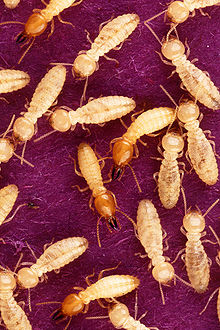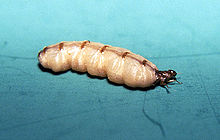- Formosan subterranean termite
-
Formosan subterranean termite 
Scientific classification Kingdom: Animalia Phylum: Arthropoda Class: Insecta Order: Isoptera Family: Rhinotermitidae Genus: Coptotermes Species: C. formosanus Binomial name Coptotermes formosanus
Shiraki, 1909The Formosan subterranean termite (Coptotermes formosanus) is an invasive species of termite. It has been transported worldwide from its native range in southern China to Formosa (Taiwan, where it gets its name) and Japan. In the 20th century it became established in South Africa, Hawaii and in the continental United States.
The Formosan subterranean termite is often nicknamed the super-termite because of its destructive habits. This is because of the large size of its colonies, and the termites' ability to consume wood at a rapid rate. A single colony may contain several million individuals (compared with several hundred thousand termites for other subterranean termite species) that forage up to 300 feet (100 m) in soil. A mature [1] Formosan colony can consume as much as 13 ounces of wood a day (ca. 400 g) and severely damage a structure in as little as three months. Because of its population size and foraging range, the presence of a colony poses serious threats to nearby structures. Once established, Formosan subterranean termites have never been eradicated from an area.
Formosan subterranean termites infest a wide variety of structures (including boats and high-rise condominiums) and can damage trees. In the United States, along with another species, Coptotermes gestroi, also introduced from south east Asia, they are responsible for tremendous damage to property resulting in large treatment and repair costs.
The Formosan subterranean termite acquired its name because it was first described in Taiwan in the early 20th century, but C. formosanus is probably endemic to southern China. This destructive species was apparently transported to Japan prior to the 17th century and to Hawaii in the late 19th century (Su and Tamashiro 1987). By the 1950s, it was reported in South Africa and Sri Lanka. During the 1960s it was found in Texas, Louisiana, and South Carolina. In 1980, a well-established colony was thriving in a condominium in Hallandale Beach, Florida. Formosan termites are rarely found north of 35° north latitude. They have been reported from eleven states including: Alabama, California, Florida, Georgia, Hawaii, Louisiana, Mississippi, North Carolina, South Carolina, Tennessee, and Texas. Their distribution will probably continue to be restricted to southern areas of the United States because the eggs will not hatch below about 20°C (68 °F).
Contents
Biology
C. formosanus is a generalist, colonial, social insect building colonies either above or below ground (Howarth 1985) and produces naphthalene as a protective poison. Termites have a caste system including: a king, queen, workers, soldiers, and reproductives or alates (winged termites). The workers provide the food, soldiers defend the nest, and reproductives breed the colony. The queen of the colony has a life span of approximately 15 years and is capable of producing up to 2,000 eggs per day. The workers and soldiers may live 3–5 years with caste proportions of approximately 360 workers: 40 soldiers (Grace et al. 1996a). A colony is surrounded by an extensive foraging system consisting of tunnels underneath the ground, with a mature colony containing millions of termites (Tulane 2002, ARS 2002). Grace et al. (1995) found older and less vigorous colonies contained workers who had a larger body mass than workers in younger colonies. The diet of the subterranean termite consists of anything that contains wood fiber (homes, building, live trees), crops, and plants. Live trees include: Oak, Ash, and water-bound Cypress (ARS 2002). Crops include sugarcane (Broughton and Grace 1994).
Nutrition
Cabrera et al. (2001) found that "Like many other termites, the Formosan termite feeds on wood and other materials that contain cellulose, such as paper and cardboard. Bacteria and other single-celled organisms live in the termite digestive system and digest cellulose providing nutrition and energy for these termites. Although they feed mostly on wood, they will eat other cellulose-containing materials such as cardboard and paper. However, they are known to chew through foam insulation boards, thin lead and copper sheeting, plaster, asphalt, and some plastics."
Morales-Ramos and Rojas (2003) found that "colonies of C. formosanus feeding on pecan, Carya illinoensis (Wangenh.), and red gum, Liquidambar styraciflua L., produced significantly more progeny than colonies feeding on other wood species tested. Progeny of colonies feeding on pecan and American ash, Fraxinus americana L., had significantly greater survival than progeny of colonies feeding on other wood species. Colonies feeding on nutritionally supplemented cellulose based matrix showed similar fitness characteristics as colonies feeding on the best wood treatments. These results indicate that differences observed in colony fitness can be partially explained by nutritional value of the food treatment, raising the possibility that wood from different tree species have different nutritional values to the Formosan subterranean termites. This suggests that feeding preference of C. formosanus is at least partially influenced by the nutritional value of the food source."
Reproduction
Su and Scheffrahn (2000) report that, "A single colony of C. formosanus may produce over 70,000 alates. After a brief flight, alates shed their wings. Females immediately search for nesting sites with males following closely behind. When the pair find a moist crevice with wooden materials, they form the royal chamber and lay approximately 15 to 30 eggs. Within two to four weeks, young termites hatched from the eggs. The reproductives nurse the first group of young termites until they reach third instar. One to two months later, the queen lay the second batch eggs which would be eventually nursed by termites from the first egg batch. It may take three to five years before a colony reach substantial number to cause severe damage and produce alates."
Lifecycle stages
Cabrera et al. (2001) state that, "After swarming and landing on the ground, the alates break off their wings and search for a mate. Once a mate is found, the male and female search for a crevice in damp ground or wood, hollow out a small chamber, and crawl inside. The pair, now known as the king and queen, mate and within a few days the queen starts laying eggs. The young, known as larvae, hatch from the eggs and are fed by the king and queen. A mature colony contains distinct groups called castes. These castes look different from one another and each has a special duty within the colony. The king and queen C. formosanus are the primary reproductives and are responsible for reproduction. If the queen or king dies or the colony becomes large, secondary reproductives may form and begin reproduction. Soldiers defend the colony against predators and other natural enemies. Workers take care of and feed the larvae, reproductives and soldiers, tend the eggs, build and maintain the nest, and search for food. Alate nymphs become alates when they are fully grown."
References
External links
- Taxonomy of termites
- Distribution in the United States
- Formosan subterranean termite on the UF / IFAS Featured Creatures Web site
- Earlham College Senior Seminar 2002
- Global Invasive Species Database
- Formosan Fact Sheet
- Termite Treatment Options
- Species Profile- Formosan Subterranean Termite (Coptotermes formosanus), National Invasive Species Information Center, United States National Agricultural Library. Lists general information and resources for Formosan Subterranean Termite.
Categories:- Termites
- Invasive animal species
- Animals described in 1909
Wikimedia Foundation. 2010.

